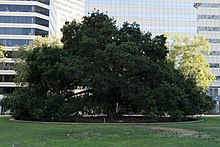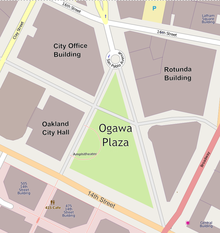Oscar Grant Plaza
 Oak Tree growing in Frank H. Ogawa Plaza | |
| Former name(s) | City Hall Plaza |
|---|---|
| Namesake | Frank H. Ogawa |
| Area | 160,000 square feet (15,000 m) |
| Coordinates | 37°48′18″N 122°16′18″W / 37.8050°N 122.2718°W |
| Construction | |
| Inauguration | 1998 |


Frank H. Ogawa Plaza is a public square located in Downtown Oakland.
Location and elements
Frank H. Ogawa Plaza is located where San Pablo Avenue converges with Broadway and 14th Street. The west side of the plaza is the site of Oakland City Hall and a city office building. Around the plaza are several Beaux-Arts styled commercial buildings from the early 20th century. New buildings have been constructed to fit visually with the older architecture.
The plaza is a 160,000-square-foot (15,000 m) public space. Most of the plaza is composed of "The Commons", a raised lawn. The plaza also features "The Forum", or amphitheater—a space for public gatherings and performances. A portion of San Pablo Avenue which runs along the north side of the plaza has been pedestrianized and incorporated into the plaza, along with the blocks of 15th Street on either side of the plaza. An entrance to the 12th Street Oakland City Center BART station is located at the intersection with Broadway. At the center of the plaza is a single large Coast Live Oak, the symbol of the city.
The plaza is adjacent to the Oakland City Center complex, directly across 14th Street to the south. Latham Square, a small plaza where Telegraph Avenue converges with Broadway, is one block to the northeast.
History
In 1896, the San Francisco Chronicle reported on a young Jack London giving speeches in what was then called "City Hall park". The open space in front of the city hall was part of Oakland's Administrative Buildings project that included the redevelopment of the city center in 1994. 1998 marked the completion of the renovated plaza.
Along with being the seat of government, the area has become part of the city's arts culture with the annual Art and Soul Festival and publicly commissioned art. In 2001, the city council commissioned a sculpture for the plaza from artist Bruce Beasley. The sculpture, Vitality, was completed in 2002.
The plaza has been the site of various protests and civil disobedience.
Name of the plaza
In 1998, the Oakland City Council renamed City Hall Plaza as "Frank H. Ogawa Plaza" in honor of Frank H. Ogawa, a civil rights leader and the first Japanese American to serve on the Oakland City Council. Ogawa served on the Council from 1966 until his death in 1994. The plaza displays a bronze bust of Ogawa.
Occupy Oakland
Members of Occupy Oakland used Ogawa Plaza as a main protest encampment in the fall of 2011. Their presence was criticized for potential health and safety concerns. However, others defended the camp, presenting statistics showing that Oakland became safer during the occupation; they showed e-mails of police attempting to cover that up. Frank H. Ogawa Plaza was unofficially renamed as "Oscar Grant Plaza" by the Occupy Oakland protesters. Oscar Grant was a young Hayward man who was killed by a Bay Area Rapid Transit police officer in 2009.
References
- ^ Dinkelspiel Cerny, Susan (2007). An Architectural Guidebook to San Francisco and the Bay Area. Gibbs Smith. p. 247. ISBN 978-1-58685-432-4.
- ^ Fentress Bradburn: Selected and Current Works. Images Publishing. 1998. p. 188. ISBN 978-1-875498-86-4.
- ^ "Oakland City Hall Plaza". Pyatok Architects. Archived from the original on September 3, 2011. Retrieved November 8, 2011.
- ^ "Jack London, who is known as the boy socialist of Oakland, is holding forth nightly to the crowds that throng City Hall Park. There are other speakers in plenty, but London always gets the biggest crowd and the most respectful attention. the young man is a pleasant speaker, more earnest than eloquent, and while he is a broad socialist in every way, he is not an anarchist" [1] Archived 2011-10-25 at the Wayback Machine
- ^ Quatman, G. William (2001). Design-Build for the Design Professional. Aspen Law & Business. p. 284. ISBN 978-0-7355-1727-1.
- ^ Fowler, Carol (2003). Insiders' Guide to Berkeley and the East Bay. Globe Pequot Press. p. 202. ISBN 978-0-7627-2373-7.
- ^ Ellwood, Mark; Edwards, Nick (2009). The Rough Guide to San Francisco & the Bay Area. Penguin Publishing. p. 16. ISBN 978-1-4053-8437-7.
- ^ Resolution on Plaza Art
- ^ SF Gate - 2001-02-16 Oakland Sculptor Beasley Selected / Panel picks art for City Hall Plaza
- ^ "Oakland History Timeline". City of Oakland, Oakland History Room of the Oakland Public Library. Archived from the original on 2011-11-12. Retrieved 2011-11-08.
1998 Named in honor of late Oakland City Councilmember Frank H. Ogawa, City Hall Plaza re-opens after a $124 million rebuilding.
- ^ Eshoo, Anna (1994-07-21). "TRIBUTE TO FRANK H. OGAWA". Congressional Record Volume 140, Number 96. United States House of Representatives. Retrieved 2011-10-31.
Mr. Speaker, I rise today to pay tribute to Frank Ogawa--a dedicated public servant, outstanding civil rights leader, and loving husband and father--who died earlier this month in Oakland, California.
- ^ Allen, Annalee; Lee, Sam. Oakland City Center: Frank H. Ogawa Statue (video). EzineMark.com. Archived from the original on 2012-04-25. Retrieved 2011-10-31.
- ^ "Rats and drugs mar Occupy Oakland tent city, officials say". 18 October 2011.
- ^ "No Surprise: Oakland Police Chief Lied to Discredit Occupy Oakland". Daily Kos.
- ^ "Emails exchanged between Oakland OPD Reveal Tensions during occupy ordeal". KTVU.
- ^ Abraham, Zennie (2011-10-30). "Occupy Oakland: The Oscar Grant / Frank Ogawa Plaza Issue". San Francisco Chronicle. Archived from the original on 2011-11-05. Retrieved 2011-11-11.

